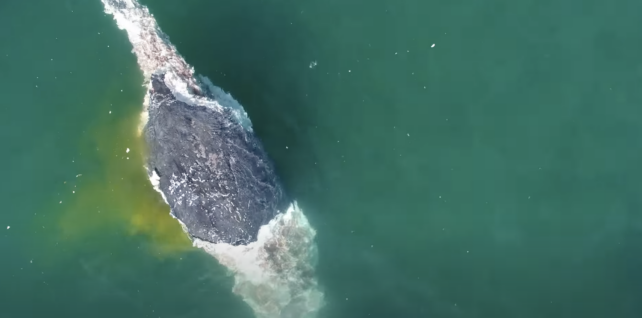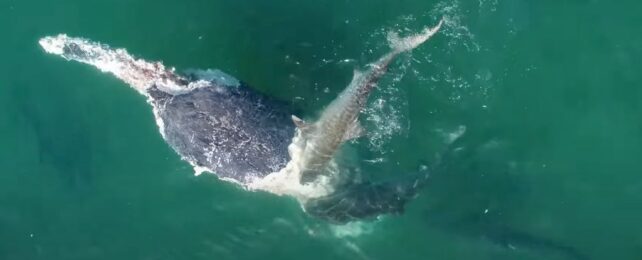Tiger sharks are usually solitary creatures, but nothing brings the scavengers together like the delicious scent of a dead whale.
These big blubber buffets can draw dozens of sharks all at once, yet such feasts are seldom caught on camera.
In late June, a drone flying off the coast of Queensland, Australia captured an exceptional gathering of around 50 tiger sharks tearing into the carcass of a deceased humpback whale.
The rare sight is important for shark research and also serves as a warning to local swimmers.
"Where there are dead whales, there are likely sharks nearby and this vision clearly shows why this is the case," cautions Senior Ranger Daniel Clifton from Queensland's Department of Environment and Science (DES).
"The death of one whale, although sad, creates a life source for many other scavenging animals including fish, sharks, and other marine life. We're fortunate here in the Great Sandy Marine Park that we can experience these natural processes first-hand."

To ensure the natural feeding event could continue to be observed easily offshore, officials anchored the humpback's remains to a secure spot in Hervey Bay.
From directly above, the drone footage shows the shadows of sharks circling the whale's carcass. Occasionally, an individual shark can be seen darting in and grabbing onto the whale, whipping its body back and forth as it tries to tear off a bite.
At one point in the video you can actually see a yellow-tinged cloud drifting from beneath the whale as the frenzy of sharks attack it from underneath; a likely sign of its stomach gases and juices seeping into the water.

Scientists have only been studying whale scavenging events like this one for the past 30 years or so, and while tiger sharks (Galeocerdo cuvier) are frequent visitors, it's not uncommon for their species to be joined by others, like great white sharks (Carcharodon carcharias) or bull sharks (Carcharhinus leucas).
Off the coast of Australia, researchers have actually recorded a couple of instances where great whites and tiger sharks have simultaneously fed on whale carcasses in apparent peace.
Saltwater crocodiles (Crocodylus porosus) can sometimes even join the fray.

Sharks might be some of the first creatures to reach a whale banquet, but their leftovers keep deep ocean ecosystems busy for decades.
When a whale dies naturally, the blubber and gas in its body keeps it floating for a while. As scavengers begin to pick away at the remains, however, the skeleton inevitably begins to sink.
This is called a 'whale fall', and it provides ocean floor creatures with essential nutrients from above. Eels, worms, crabs, and octopuses have all been recorded feasting on the skeletons of whales at extreme depths. They even chow down on the bones.
With so many hungry mouths to feed, no part of a dead whale goes to waste.
Even in death, these noble creatures bring renewed life to the ocean.
